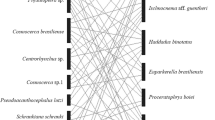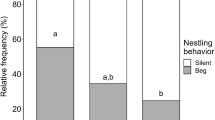Abstract
Dinarmus basalis (Rond) and Epelmus vuilleti (Crw) are two Hymenopteran species, which are solitary ectoparasitoids of bruchid larvae. In the presence of seeds of Vigna unguiculata (Walp) containing hosts parasitized by E. vuilleti, a high percentage of D. basalis females avoided multiparasitism whatever the age of the eggs or the larvae present on the host. The least avoidance was observed when the hosts were parasitized by E. vuilleti 30 min beforehand. This avoidance behavior is adaptive and is related to the low survival chances of the D. basalis larvae when they are in interspecific competition with E. vuilleti larvae. The analysis of the behavior of D. basalis demonstrated that the avoidance of multiparasitism could be due to the perception of two signals; an external signal deposited on the surface of the seeds during the E. vuilleti oviposition phase and an internal signal due to the presence of the eggs and larvae at the surface of the hosts. E. vuilleti females did not avoid multiparasitism and multiparasitized the hosts bearing D. basalis eggs or larvae. The behavior of E. vuilleti females was not disturbed by the presence of its competitor. Under these conditions of interspecific competition, the survival chances of E. vuilleti larvae were very high whatever the age of its competitor D. basalis. The two species of parasitoids could move in a column containing healthy seeds of V. unguiculata and patches with seeds containing parasitized or unparasitized larvae. The distribution of D. basalis females introduced into these columns depended on the host quality. They avoided the patches containing the hosts parasitized E. vuilleti and were found in the patches with healthy hosts. The behavior of E. vuilleti females was very different; the distribution of the females and the parasitism and multiparasitism rates were not affected by the quality of the hosts present in the patches. The adaptive significance of the behaviors of these two species was analyzed in relation to the survival chances of their offspring.
Similar content being viewed by others
REFERENCES
Bolter, C. J., and Laing, J. E. (1983). Competition between Diadegma insulare and Microplitis plutellae for larvae for the diamondback moth Plutella xylostella. Proc. Entomol. Soc. Ont. 114: 1–10.
Browning, H. W., and Oatman, E. R. (1984). Intra-and interspecific relationships among some parasites of Trichoplusia ni. Environ. Entomol. 13: 651–656.
Chow, F. J., and Mackauer, M. (1984). Inter-and intraspecific larval competition in Aphidius smithi and Praon pequodorum (Hymenoptera: Aphididae). Can. Entomol. 116: 1097–1107.
Chow, F. J., and Mackauer, M. (1986). Host discrimination and larval competition in the aphid parasitoid Ephedrus californicus. Entomol. Exp. Appl. 41: 243–254.
Cortesero, A. M. (1994). La recherche de l'hôte chez Eupelmus vuilleti (Crw.) Analyse des relations tritrophiques entre la plante Vigna unguiculata (Walp), l'hôte Bruchidius atrolineatus (Pic) et le parasitoïde, Thèse de doctorat, University of Tours, Tours.
Cortesero, A. M., Monge, J. P., and Huignard, J. (1993). Response of the parasitoid Eupelmus vuilleti to the odours of the phytophagous host and its host plant in an olfactometer. Entomol. Exp. Appl. 69: 109–116.
Cortesero, A. M., Monge, J. P., and Huignard, J. (1997). Dispersal and parasitizing abilities of Eupelmus vuiletti within a column of cowpea seeds. Environ. Entomol. 26(5): 1025–1030.
Doury, G., Rojas-Rousse, D., and Périquet, G. (1995). Ability of Eupelmus orientalis ectoparasitoid larvae to develop on an unparalysed host in the absence of female stinging behaviour. J. Insect Physiol. 41: 287–296.
Gauthier, N. (1996). Etude d'un ectoparasitoïde Dinarmus basalis (Rond) en situation de compétitions intra-et interspécifique: Activité reproductrice et réponses comportementales, Thèse de doctorat, University of Tours, Tours.
Gauthier, N., Monge, J. P., and Huignard, J. (1996). Superparasitism and host discrimination in the solitary ectoparasitoid Dinarmus basalis. Entomol. Exp. Appl. 79: 91–99.
Godfray, H. C. J. (1994). Parasitoids: Behavioural and Evolutionary Ecology, Princeton University Press, Princeton, NJ.
Guillot, F. S., and Vinson, S. B. (1972). The role of the calyx and poison glands of Cardiochiles nigriceps in the host parasitoid relationships. J. Insect Physiol. 18: 1315–1321.
Höller, C., Bargen, H., Vinson, S. B., and Braune, H. J. (1993). Sources of the marking pheromones used for host discrimination in the hyperparasitoid Dendrocerus carpenti. J. Insect Physiol. 59(8): 649–656.
Lévêque, L., Monge, J. P., Rojas-Rousse, D., van Alebeek, F., and Huignard, J. (1993). Analysis of multiparasitism by Eupelmus vuilleti (Eupelmidae) and Dinarmus basalis (Pteromalidae) in the presence of their common hosts, Bruchidius atrolineatus (Coleoptera: Bruchidae). Oecologia 94: 272–277.
Mangel, M. (1989). An evolutionary interpretation of the “motivation” to oviposit. J. Evol. Biol. 2: 157–172.
McBrien, H., and Mackauer, M. (1991). Decision to superparasitize based on larval survival: Competition between aphid parasitoids Aphidius ervi and Aphidius smithi. Entomol. Exp. Appl. 59: 145–150.
Monge, J. P., and Huignard, J. (1991). Population fluctuations of two bruchid species Callosobruchus maculatus (F.) and Bruchidius atrolineatus (Pic.) and their parasitoids Dinarmus basalis (Rondani) and Eupelmus vuilleti (Crawford) (Hymenoptera, Pteromalidae, Eupelmidae) in a storage situation in Niger. J. Afr. Zool. 105: 187–196.
Monge, J. P., Dupont, P., Idi, A., and Huignard, J. (1995). The consequences of interspecific competition between Dinarmus basalis (Rond) (Hymenoptera: Pteromalidae) and Eupelmus vuilleti (Crw) (Hymenoptera: Eupelmidae) on the development of their host populations. Acta Oecol. 16(1): 19–30.
Ouedraogo, A. P., Sou, S., Sanon, A., Monge, J. P., Huignard, J., Tran, B., and Credland, P. (1996). Influence of temperature and humidity on population of Callosobruchus maculatus and its parasitoid Dinarmus basalis in two zones of Burkina Faso. Bull. Entomol. Res. 86: 695–702.
Pawson, B. P., Petersen, J. J., and Holtzer, J. O. (1987). Competitive parasitism of house fly pupae (Diptera: Muscidae) by Muscidifurax zaraptor and Urolepsis rufipes (Hymenoptera: Pteromalidae). J. Med. Entomol. 24(1): 66–70.
Rabb, R. L., and Bradley, J. R. (1970). Marking host eggs by Telenomus sphingis. Ann. Entomol. Soc. Am. 63: 1053–1056.
Sanon, A., Ouedraogo, A. P., Tricault, Y., Credland, P. F., and Huignard, J. (1998). Biological control of Bruchids in cowpea stores by release of Dinarmus basalis adults. Environ. Entomol. 27(2): 717–725.
Scholz, D., and Höller, C. (1992). Competition for hosts between two hyperparasitoids of aphids, Dendrocerus laticeps and Dendrocerus carpenteri (Hymenoptera: Megaspilidae): The benefit of interspecific host discrimination. J. Insect. Behav. 5 (3): 289–300.
van Alphen, J. J. M., and Vet, L. E. M. (1986). An evolutionary approach to host finding and selection. In Waage, J. K., and Greathead, D. (eds.), Insect Parasitoids, Academic Press, London, pp. 23–61.
van Baaren, J., Boivin, G., and Nénon, J. P. (1994). Intra-and interspecific host discrimination in two closely related egg parasitoids. Oecologia 100: 325–330.
Vet, L. E. M., Meyer, M., Bakker, K., and van Alphen, J. J. M. (1984). Intra-and interspecific host discrimination in Asobara tabida larval endoparasitoids of Drosophilidae: Comparison between closely related and less closely related species. Anim. Behav. 32: 871–874.
Visser, M. E., van Alphen, J. J. M., and Nell, H. W. (1990). Adaptive superparasitism and patch time allocation in solitary parasitoids: The influence of the number of parasitoids depleting a patch. Behav. Ecol. 114(1–4): 21–36.
Visser, M. E. (1992). Adaptive self-and conspecific superparasitism in the solitary parasitoid Leptopilina heterotoma (Hymenoptera: Eucoilidae). Behav. Ecol. 4: 22–28.
Wai, K. M., and Fujii, K. (1990). Intraspecific larval competition among wasps parasitic of bean weevil larvae. Res. Pop. Ecol. 32: 85–98.
Wajnberg, E., Pizzol, J., and Babault, M. (1989). Genetic variation in progeny allocation in Trichogramma maidis. Entomol. Exp. Appl. 53: 177–187.
Author information
Authors and Affiliations
Rights and permissions
About this article
Cite this article
Gauthier, N., Sanon, A., Monge, J.P. et al. Interspecific Relations Between Two Sympatric Species of Hymenoptera, Dinarmus basalis (Rond) and Eupelmus vuilleti (Crw), Ectoparasitoids of the Bruchid Callosobruchus maculatus (F). Journal of Insect Behavior 12, 399–413 (1999). https://doi.org/10.1023/A:1020847707439
Issue Date:
DOI: https://doi.org/10.1023/A:1020847707439




